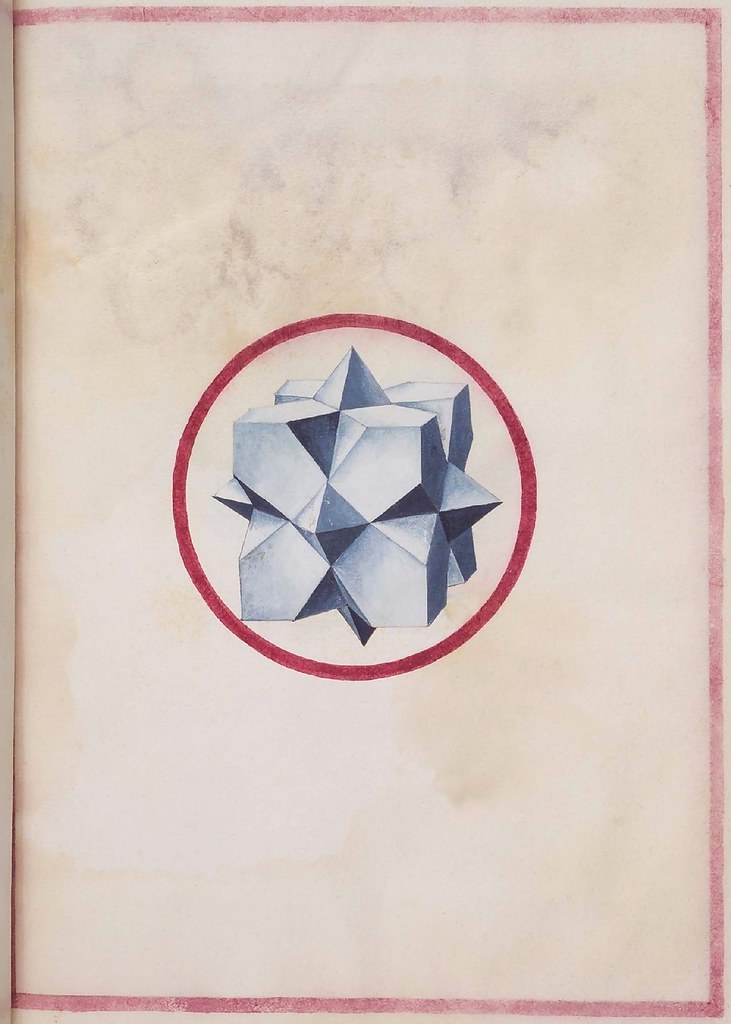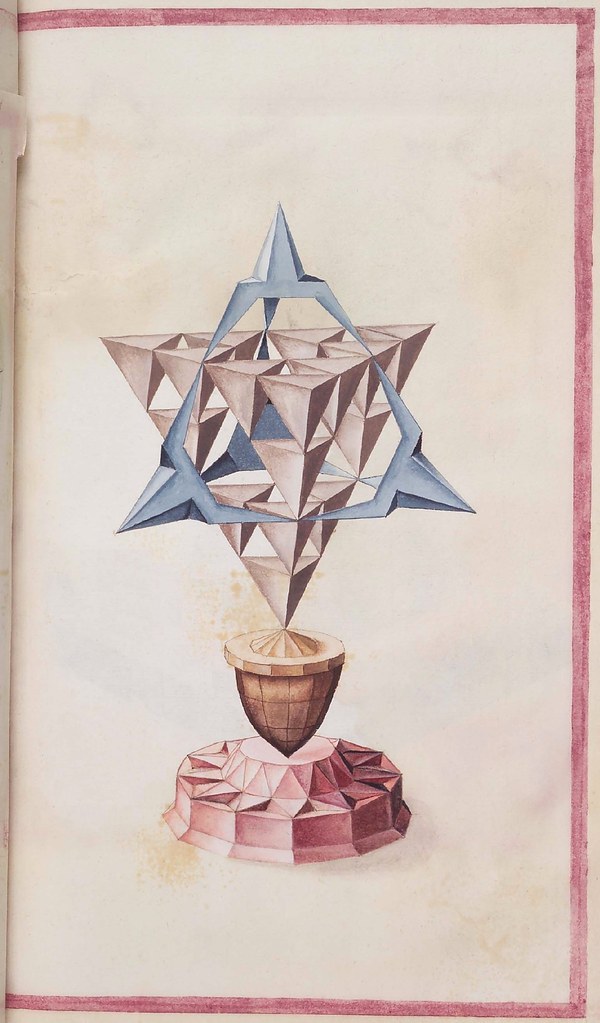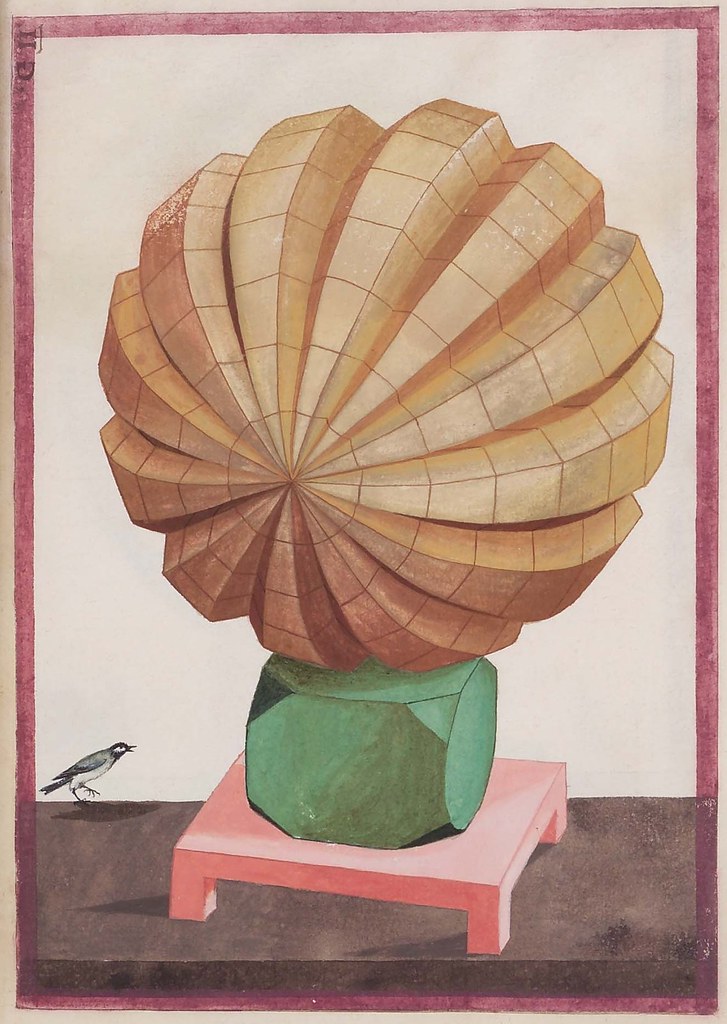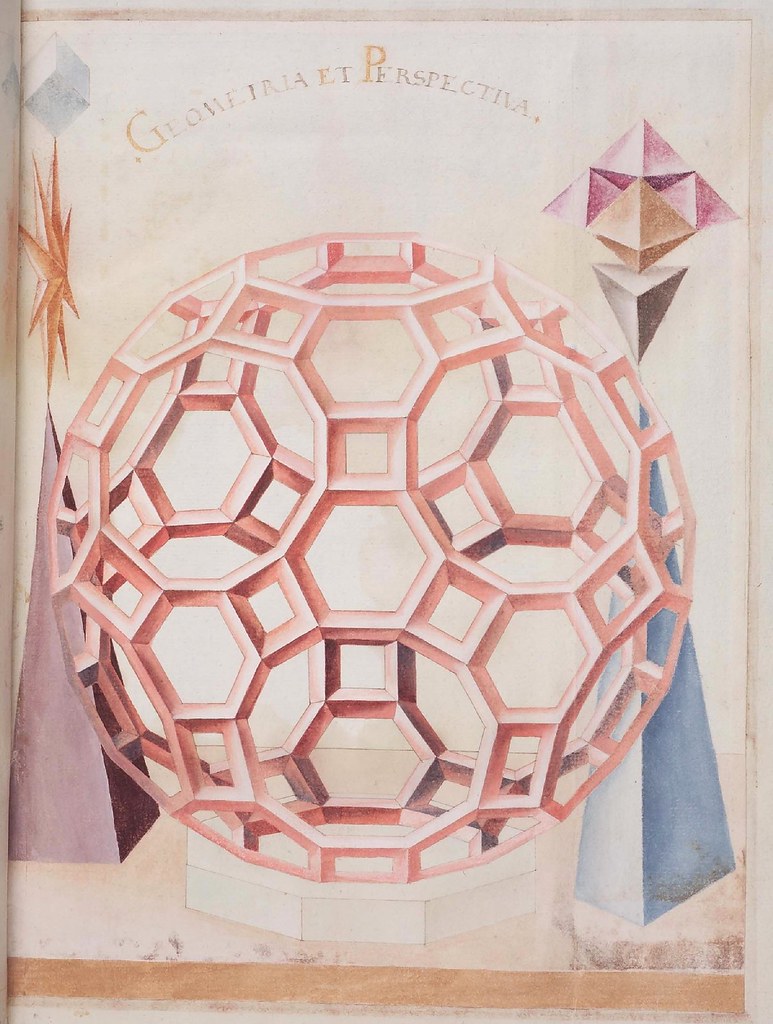The images below (background spot-cleaned) come from a rather obscure 16th century anonymous paper manuscript containing sketches of geometric solids. The illustrations have been cropped from the slightly larger full-page layouts.














The album of geometric and perspective drawings (Codex Guelf 74. 1. Aug. fol.) from the 1500s is available online from Herzog August Bibliothek in Wolfenbüttel (thumbnail pages).
It consists of more than thirty watercolour sketches of polyhedra^ or, as the Latin title on one of the images above has it, perspectives of the regular solids (a standard descriptive name, originating with Plato and Euclid).
There are virtually no references to this manuscript anywhere online and no further dating clues beyond "the 16th century". I would cautiously suggest**, therefore, that it likely dates to the latter half of the century. It is possibly copied from, or modelled after - but with the added whimsy of wildlife - some other works on geometrical shapes from after 1550 by Nuremberg/Augsburg artists such as Stoer, Lencker and Jamnitzer {links below}. [However, Nuremberg is a long way from Wolfenbüttel]
**idea may contain nuts
Previously, of particular note (each post contains many related links) :
- Jamnitzer Perspectiva
- Geometric Landscape
- And on Giornale Nuovo: Perspectiva Literaria
- Tangentially: Perspectiva
Thanks also to Marius for his timely reminder of George W Hart's Rapid Prototyping page.
Time, too, for a random shoutout to the Rouimi Art Institute (Calligraphy & Ebru marbling suppliers).



















22 comments :
I agree with your comment on dating probably contemporaneous with Jamnitzer
I'd just like to say that I love this blog, it's a never ending source of inspiration! Especially with awesome posts like this! I don't normally have anything to say but I think you are doing a great job and hope you'll keep it up! AWESOMEEEE!! :)
Someone had a lot of fun making those pages. I wish my geometry class had been taught in a similar spirit!
Utterly fantastic. I want to eat them.
In the 16th century the connections between the Nürnberg artists and craftsmen and Saxony were very strong. There are lots of Nürnberg artifacts in Wolfenbüttel and other archives and collections in Saxony so the connection is highly probable.
G'day Chris! I really try to avoid the FB thing these days: thanks for stopping by.
Zyzann, you make me blush. Cheers!
I hear you Thony and thanks for the opinions, but 400km is still a long way in anyone's 16th century. I see there's no river connection either. Obviously there was a bustling economy and trade routes etc so I don't doubt you. I just wouldn't have predicted such a demonstrable connection.
raul, please don't eat the blog pictures. I cleaned off the spots in the background, but that's 400+ year old stains you see above. Images don't come with health insurance.
What a wonderful study in perspective! Great artist's reference work.
These are so odd. I kind of love them.
peacay: 1) Nürnberg was the leading trading city in Northern Europe
2) Saxony was the home of Martin Luther & Phillip Melanchthon whereas Nürnberg was the very first Protestant city.
3) The Nürnberg artists, craftsmen and instrument maker were among the best in Europe
4) Saxony was very rich
You do a great job cleaning and trimming- i know how much work that is! Thank you for your always enlightening and fascinating site! I will be including these in my future perspective classes.
What a compelling blog! Your collection of imagery is wonderful. I especially love this post! Bravo! I'll be back!
I loved "the added whimsy of wildlife" (especially the cockerel's "surprised" stance in the first picture. You should add a warning: "These pictures might shock a cock!").
These are excellent, but I'm not sure it's correct to describe them as perspective drawings. There are no horizon lines or vanishing points. It's as if the viewer is standing at an infinite distance from the objects. I believe that "orthographic projection" is the technical term for this type of rendering, a pre-Renaissance mode, since the viewer isn't expected to have a unique "point of view:.
Elliott Banfield, I've no doubt you're probably correct in a technical sense. In the case here, the bibliographic record for this album reads:
"Sammlung geometrischer und perspectivischer, in Farben ausgeführter Zeichnungen, 36 Blätter umfassend. — Cod. Guelf. 74.1 Aug. 2° — Signaturdokument"
This is one work among a genre and the convention, since Euclid (as I understand it, although perhaps it dates simply to Dürer), is to include these solid body or orthographic projections as part of the 'perspective' works. So it's more a naming tradition (I think) rather than being a precise specification.
In the Middle Ages works on perspective referred to works on geometrical optics. The word was extended to include linear perspective in the 15th century. As far as I'm aware the first person to include studies of three dimensional solids and orthographic projection in a work on linear perspective was Piero della Francesca who effectively established the tradition.
I'm sure M.C. Escher would have loved this. Brilliant.
What a great post - as always. I am afraid though that the website "Giornale Nuovo" is no longer around. I remember when he said that he would not be updating it any more and I saved a ton of posts but it's no longer up which is a shame.
Ouch! Thanks Nancy : what you clicked was actually a borked link. I'm surprised noone had mentioned it before. *wags finger at silent masses*
From MrH: Perspectiva Literaria
And while Giornale Nuovo has not been 100% retained, Stuart went to some trouble last year to salvage a large selection of posts for which he now provides a very handy summary page:
The Annotated List page of Giornale Nuovo in reverse chronological order.
THANK YOU for providing an updated link. Your page and his were (are) the most unique and fascinating ones of the genre on the Internet.
Reminds me of Kepler's early model of the solar system comprised of nested platonic solids. Same time period too. (late 16th century)
These are beautiful. I did notice that one of the pieces (#79 of the original collection, the one with the spiraling broken tori) http://diglib.hab.de/mss/74-1-aug-2f/start.htm?image=00079 is nearly identical to this one of Lencker's http://www.mathe.tu-freiberg.de/~hebisch/cafe/lencker/perslit21.html. Could this mean that this is the work of Lencker, or could someone have copied and colored his work?
Thanks Dave. Well, that's the speculation I folded in at the end, above. I'm out of my depth though; I'd like to read some academic papers/commentary on the whole milieu associated with the 'perspective'/'regular solid' art world. I've certainly found and posted material from all the main - digitised - works, but I don't know much about the larger overview in biographical and geographical proximity terms etc for those involved (though I acknowledge Thony has laid out a case for easy idea transmission in that general area).
Post a Comment
Comments are all moderated so don't waste your time spamming: they will never show up.
If you include ANY links that aren't pertinent to the blog post or discussion they will be deleted and a rash will break out in your underwear.
Also: please play the ball and not the person.
Note: only a member of this blog may post a comment.